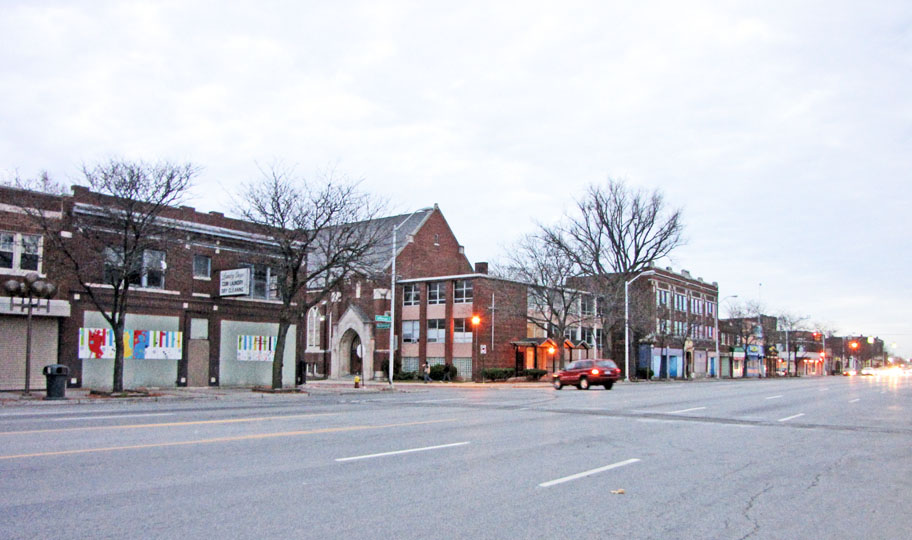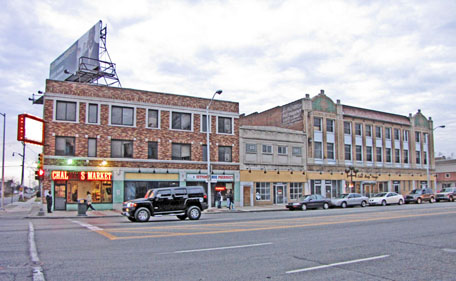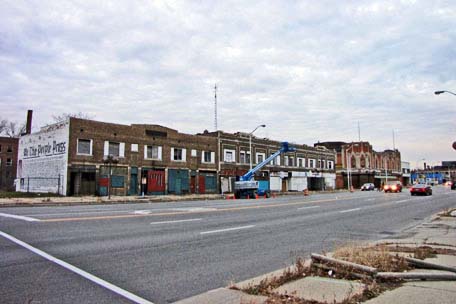

This recently inscribed historic district is located within the Jefferson East neighborhood of Detroit. That neighborhood is bounded by Detroit’s city limit to the north—that is, by Altar Road; by the Detroit River on the East, by St. Jean Street on the West and by Charlevoix on the South. It includes Detroit’s well known array of cigarette streets—Newport, Phillip and Marlborough. This is the far northeast corner of Detroit, sometimes identified as Detroit’s Lower East Side.
Detroit grew as a manufacturing center after the Civil War. Most of the early firms located on or near the Detroit River since ships were used for transportation. By the 1860s, increasingly reliable railroads gave firms more options about where to locate their workshops and factories. Approaching 1900, this area on the far east side of Detroit was unoccupied and not incorporated into the city. I believe that it was still part of Hamtramck Township. Realizing that more manufacturing firms would build factories, Detroit railroads, in 1905, began to construct a new belt line that would extend from the waterfront on the far east side of current city of Detroit, curve toward the west and northwest of Milwaukee Junction, go through Highland Park and proceed on to meet the main line of the Michigan Central not far from the Detroit-Dearborn border. The shape was similar to that of Grand Boulevard. The 18 mile line was the Detroit Terminal Railroad and was owned by the largest intercity railroads serving Detroit: the Michigan Central, the New York Central and the Grand Trunk. Manufacturers located plants along this line quickly and, by 1914, it served about 50 firms including Detroit Edison’s large east side power plant. The area where the new Jefferson East Chrysler production plant now stands is close to the former locations of several automotive firms including Chalmers, Continental, Hudson and Lozier. Not surprisingly, Ford also had a plant in this area but I don’t think it was an assembly plant.
Homes were built in this area shortly after the arrival of the railroad and the manufacturing firms. Many of them were inexpensive structures rapidly constructed for the working men who labored in the nearby firms for modest salaries. With sufficient numbers of residents living nearby, an extensive commercial strip was erected along East Jefferson as it passed from the city of Detroit toward Grosse Pointe Shores. It is those commercial buildings that comprise the current Jefferson-Chalmers Business Historic District.
Governor Granholm’s administration adopted a “Cool Cities” initiative with the aim of reinvigorating Michigan’s cities. Richard Florida popularized the idea that if older, declining Rust Belt cities such as Detroit, wished to reinvent themselves, they should make themselves very attractive to young people who would move there and start new creative businesses. The Granholm Administration made small grants to many organizations in Michigan metropolises to create “Cool Cities” or cool neighborhoods. The business persons groups in the East Jefferson-Chalmers area successfully obtained a small amount of funding from the state and began sketching out an extensive revitalization of this area. In 2007, these promoters described the renovation of several older buildings, including the former Winston Place Apartments, the Platte Warehouse and the Chalmers building—all along Jefferson. They also described plans for the construction of 305 new single family homes in adjoining sites. Prior to this, there had been the construction of a new subdivision of expensive homes in the area between East Jefferson and the waterfront north of the former Detroit Terminal line. The commercial strip along East Jefferson was than listed on the National Register of Historic Places.
There are quite a few architecturally interesting buildings in or near this historic district. The Vanity Ballroom on East Jefferson is one and St. Columba’s Episcopal Church on Manistique is another. The very attractive Montieth Branch of the Detroit Public Library on Kercheval was closed on December 22, 2011 due to the city’s financial travails. So far as I know, nothing has been accomplished yet with regard to the revitalization and reuse of those now unused but historically building.
The industrial area along East Jefferson originally served by the Detroit Terminal Railroad is still thriving. It became a focal point for the productions of vehicles well before World War I and retains that important function in 2012. This is now the location of the large plant that manufactures the very popular Jeep Cherokee and that may, in the near future, build Mazartis for export to Europe. It adjoins a large Fiat-Chrysler engine plant. The rail line continues to serve this area but is now known as the Conrail Shared Assets.
Website for the area’s commercial association: http://www.jeffersoneast.org/
Report describing history of this area: http://www.detroitmi.gov/LinkClick.aspx?fileticket=owAuy6_iKi8%3D&tabid=3096&mid=4357
City of Detroit Designated Historic District: I do not believe this area is listed. However, the website of the City of Detroit Historic Designation Board has a long report about the historical significance of the area.
State of Michigan Registry of Historic Sites: Not listed
National Register of Historic Places: Listed June 16, 2004 #04000598
Photographs: Ren Farley
Description prepared: January, 2012
.
Return to Commercial Buildings
Return to Michigan Registered Historic Districts
Return to Federal Register of Historic Places
Return to Homepage


Return to Michigan Registered Districts
Return to Commercial Buildings